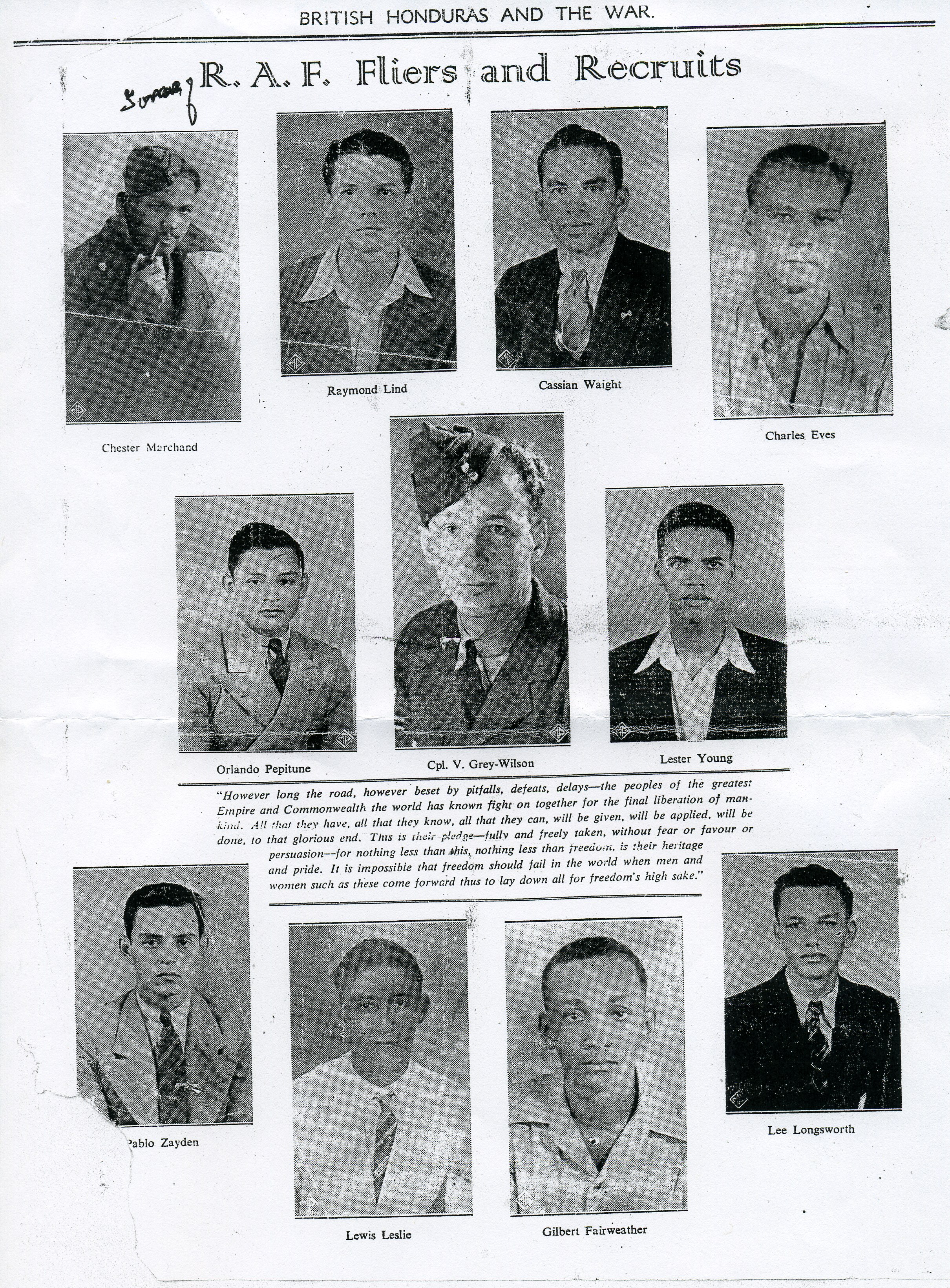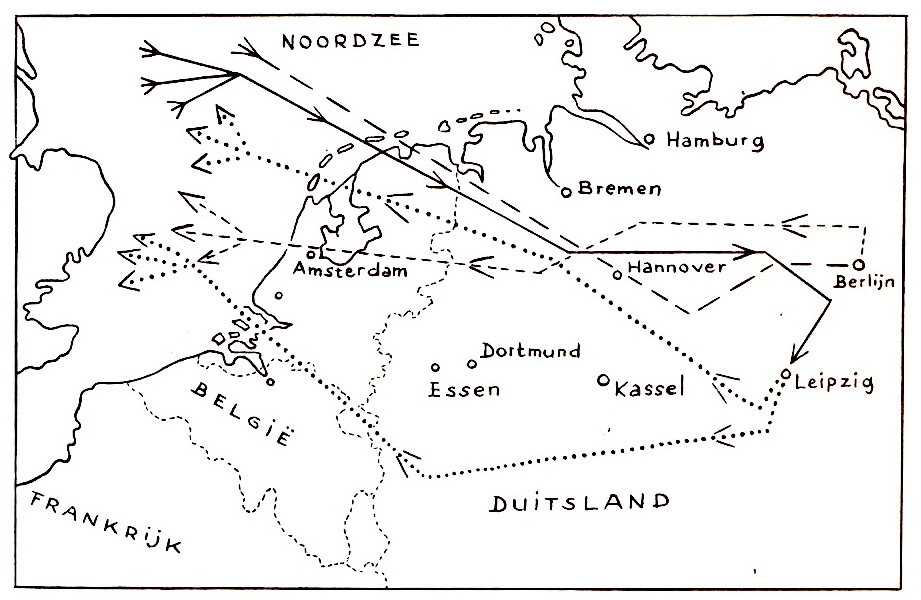1396398 – C.H. Waight – British Honduras – attested 16.9.41 – Ach/W/Op.Air
172841 – P/O – commissioned 3.2.44
[Source: NA AIR 2/6876 – Nominal Roll of Coloured Candidates, October 1944]
F/S – Henry Cassian Waight – British Honduras (Belize), born 1912
Bomb Aimer on Lancaster DV 267, 101 Squadron, SR-K
KIA 19/20-2-44 on raid to Leipzig
This aircraft was one of 109 from an order for 200 from Metropolitan Vickers built as Lancaster BIII with Merlin 28 engines and delivered between May and November 1943
Crew:
Pilot: W/O LAURENS John 171908 DFM
Buried in Leek (Tolbert) Protestant Cemetery, Row K Grave 2
Pilot2: Sgt KIBBLE W A G
POW – Prisoner No 3848 at Stalag Kopernikus
Engineer: F/Sgt BURTON L
POW – Prisoner No 3843 at Stalag Kopernikus
Navigator: Sgt AITKEN R N
POW – Prisoner No 609 at Stalag Luft Bankau – Kreulberg
B/Aim: Sgt WAIGHT Cassian Henry – 172841
Buried in Noordijk Protestant Cemetery. Row 27 Grave 10
W/Op: Sgt DAVIES J A
POW – Prisoner No 698 at Stalag Luft Bankau – Kreulberg
AG: Sgt ROYSTONE A E
POW – Prisoner 1902 at Stalag Kopernikus
AG: Sgt BOLT William Frederick Donald 1587851
Buried in Leek (Tolbert) Protestant Cemetery, Row K Grave 1
Took off from Ludford Magna at 23:38. Crashed near Tolbert, 17 km WSW of Groningen, Holland. A report claims that Sgt Waight died from a broken neck, his body was discovered at Noordijk.
W/O Laurens immediate DFM was gazetted on 25/01/44
[Source: Royal Air Force Bomber Command Losses of the Second World War Volume 5 1944 by W R Chorley]
In other source Listed as P/O, Wop/AG
http://www.panoramio.com/photo/11813844

[Source: Unknown publication, courtesy Nadia Cattouse via Audrey Dewjee]
Cassian Henry Waight: Remembrance Day in Noordwijk (the Netherlands)
A moving report of the Dutch Rememberance Day (May 4th) in the town of Noordwijk. The yearly commemoration includes a memorial service which honours Cassian Henry Waight and all the men and women who sacrificed their lives during the Second World War. The local people lay flowers at the grave of Mr. Waight and stand in silence as The Last Post is played.
[Movie by Idse van der Donk aka soopy movie on YouTube]
The Raid on Leipzig, 19/20 February 1944
Leipzig: 700.000 inhabitants, 5th biggest city of Germany, 12 aircraft factories, 8 machine and weapons factories, other war-related industries, including production of textiles and synthetic oil. Also one of the most important railway hubs of Central Germany.

[Route to/from Leipzig and diversionary attack on Berlin, 19/20 February 1944]
Among the attack force were 21 Lancasters of 101 Squadron. This unit was one of Britain’s special assets in the so-called ‘war of the airwaves’. It flew special Lancasters with a crew of eight, the extra man speaking German fluently. These ‘specials’ operated a receiver and a powerful transmitter. After picking up a German radio-communication between a ground-station and fighters in the air, the ‘special operator’ interfered and created confusion by broadcasting false information about the route of the attackers. These Lancasters also performed regular bombing missions. But since they were breaking radio-silence all the time, the were more exposed and likely to draw German attack-fighters. This squadron needed very good gunners.
One of the Lancasters of 101 Squadron did not return to their base Ludford Magna that night and came down in the northern part of the Netherlands. This aircraft, Lancaster DV267 ‘K for King’ had taken off at 23:38 with the usual crew of eight. At the base they were known as the ‘League of Nations Crew’, because they represented multiple nations.

[The crew of Lancaster DV267 SR-K (K for King, 101 Squadron), known als ‘The League of Nations Crew’, ready to go on a mission. Cass Waight on the right. Picture taken at Ludford Magna]
The captain, Pilot Officer John Laurens DFM, 26 years old, tall, well-built and a native of Cape Town, South-Africa, was a peculiar mix of a practical joker and a serious human. After leaving school he went to sea. 18 Months later he went to England and joined the Grenadier Guards, where he served until he was wounded in Dunkirk in 1940. Then he applied for transfer to the RAF and was sent to Canada for his training. He received his ‘wings’ in 1943 and ended up at the helm of a heavy Lancaster on its way to Leipzig, his 20th mission.
Next to the skipper was the position of the 22 years old Flight Sergeant Leslie – ‘Crash’ to his friends – Burton, the navigator. A tall, quiet lad from Calverley in Yorkshire. He was one of the original crewmembers and also flew his 20th mission.
Sergeant Ronald ‘Ronnie’ Aitken, the blond bomb-aimer, came from Oldfield; he stood in for French-Canadian Sergeant Jacques Marchand, who had reported ill, and had flown only one mission with the crew of ‘K for King’.
Sergeant William Alexander George Kibble, the mechanic, was English as well. He came from Hatfield, Hertfordshire.
The radio-operator, Pilot Officer Cassian Henry Waight, came from Belize, British-Honduras.
The mid-upper gunner was Sergeant William Frederick Donald Bolt and Sergeant Albert Edward Royston from Darfield was the tail-gunner.
The eighth crew-member was Sergeant James Arthur ‘Jim’ Davies, the ‘Special’. A tall, slim and gifted bloke with a boyish face from Wales. He was also new in the crew and made his second operational flight that night. Concentrated he sat bent over his most secret apparatus, known to the few as the A.B.C. or ‘Air Borne Cigar’ and soon found himself talking to a German fighter-guiding officer on the ground.
On their way to Leipzig they were attacked near Oldenburg. Suddenly they heard a drum-roll like sound and the sky lit up by flames. When they noticed that the fuel tank in the port wing was on fire, they realised they had to return to base. They dropped their bombs and headed west. Burning parts of the wing fell of and they obviously weren’t going to make it to England, so they hoped they could ditch the plane in sea and escape in their dinghy. Not an inviting prospect in the cold of a Winter’s night. The fire was spreading however and Captain Laurens ordered the men to bail by parachute. Royston and Bolt had to use an axe to open the rear escape door, keeping Davies waiting to jump. Bolt did not survive the jump. Up front Aitken and Kibble struggled to open the little forward escape hatch. Burton helped the pilot to put on his parachute before attaching his own. He noticed Waight was not wearing his harness and ordered him to put it on, but couldn’t tell if the radio-operator heard him.
At that moment the port wing broke off causing the plane to spin and Burton fell on top of the two men in the front. In Burton’s own words: “When the wing broke off I had no hope of survival. I must have fallen into the narrow passage to the nose of the bomber. The front must have broken off from the fuselage, because I fell free from the airplane. For a brief moment I saw Cass Waight in the light of the flames, probably a meter or so away from me but he did not wear his parachute gear. I have never forgotten. We had had a pretty good time together, as far as that was possible in those days.”
Burton survived his fall and was rejoined with his comrade Kibble in the home of a Dutch family. Three other crew-members survived as well. Jim Davies and Ronnie Aitken were hidden by Dutch people, but Albert Royston was handed over to the police and arrested. Burton was later arrested in The Hague and ended up in a POW camp. Three men died that night: Don Bolt, Cass Waight and Captain Jack Laurens who tried to keep the Lancaster under control till the end.
Extraordinarily and unexplicable when Waight’s body was found near Noordwijk (more that 100 km to the southwest of his crashed Lancaster) his opened parachute was there right next to him.
[Source: Gevleugeld Verleden, Ab A. Jansen (a documentary about ±200 shot-down RAF airplanes and their crews above Holland), ISBN 90 235 8099 0; Read the original pages here: Cassian Waight – Gevleugeld Verleden Ab Jansen (in Dutch)]




































 Promoting the Noble Heritage of Caribbean Air Crew who Served in Freedom's Cause in World War II - The Law Firm of Gabriel J Christian & Associates, LLC.
Promoting the Noble Heritage of Caribbean Air Crew who Served in Freedom's Cause in World War II - The Law Firm of Gabriel J Christian & Associates, LLC.